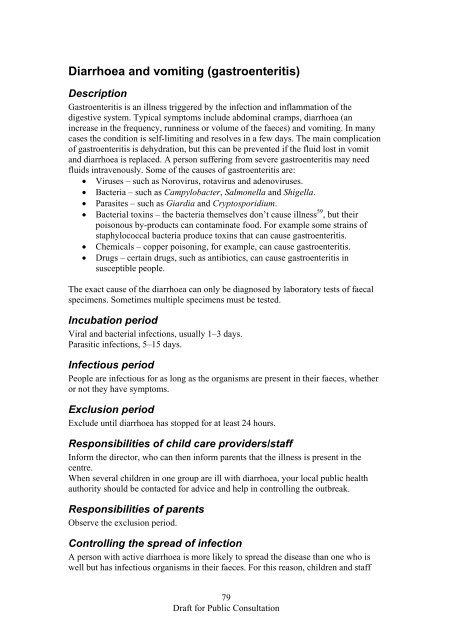Staying Healthy in Child Care - National Health and Medical ...
Staying Healthy in Child Care - National Health and Medical ...
Staying Healthy in Child Care - National Health and Medical ...
Create successful ePaper yourself
Turn your PDF publications into a flip-book with our unique Google optimized e-Paper software.
Diarrhoea <strong>and</strong> vomit<strong>in</strong>g (gastroenteritis)<br />
Description<br />
Gastroenteritis is an illness triggered by the <strong>in</strong>fection <strong>and</strong> <strong>in</strong>flammation of the<br />
digestive system. Typical symptoms <strong>in</strong>clude abdom<strong>in</strong>al cramps, diarrhoea (an<br />
<strong>in</strong>crease <strong>in</strong> the frequency, runn<strong>in</strong>ess or volume of the faeces) <strong>and</strong> vomit<strong>in</strong>g. In many<br />
cases the condition is self-limit<strong>in</strong>g <strong>and</strong> resolves <strong>in</strong> a few days. The ma<strong>in</strong> complication<br />
of gastroenteritis is dehydration, but this can be prevented if the fluid lost <strong>in</strong> vomit<br />
<strong>and</strong> diarrhoea is replaced. A person suffer<strong>in</strong>g from severe gastroenteritis may need<br />
fluids <strong>in</strong>travenously. Some of the causes of gastroenteritis are:<br />
• Viruses – such as Norovirus, rotavirus <strong>and</strong> adenoviruses.<br />
• Bacteria – such as Campylobacter, Salmonella <strong>and</strong> Shigella.<br />
• Parasites – such as Giardia <strong>and</strong> Cryptosporidium.<br />
• Bacterial tox<strong>in</strong>s – the bacteria themselves don’t cause illness 59 , but their<br />
poisonous by-products can contam<strong>in</strong>ate food. For example some stra<strong>in</strong>s of<br />
staphylococcal bacteria produce tox<strong>in</strong>s that can cause gastroenteritis.<br />
• Chemicals – copper poison<strong>in</strong>g, for example, can cause gastroenteritis.<br />
• Drugs – certa<strong>in</strong> drugs, such as antibiotics, can cause gastroenteritis <strong>in</strong><br />
susceptible people.<br />
The exact cause of the diarrhoea can only be diagnosed by laboratory tests of faecal<br />
specimens. Sometimes multiple specimens must be tested.<br />
Incubation period<br />
Viral <strong>and</strong> bacterial <strong>in</strong>fections, usually 1–3 days.<br />
Parasitic <strong>in</strong>fections, 5–15 days.<br />
Infectious period<br />
People are <strong>in</strong>fectious for as long as the organisms are present <strong>in</strong> their faeces, whether<br />
or not they have symptoms.<br />
Exclusion period<br />
Exclude until diarrhoea has stopped for at least 24 hours.<br />
Responsibilities of child care providers/staff<br />
Inform the director, who can then <strong>in</strong>form parents that the illness is present <strong>in</strong> the<br />
centre.<br />
When several children <strong>in</strong> one group are ill with diarrhoea, your local public health<br />
authority should be contacted for advice <strong>and</strong> help <strong>in</strong> controll<strong>in</strong>g the outbreak.<br />
Responsibilities of parents<br />
Observe the exclusion period.<br />
Controll<strong>in</strong>g the spread of <strong>in</strong>fection<br />
A person with active diarrhoea is more likely to spread the disease than one who is<br />
well but has <strong>in</strong>fectious organisms <strong>in</strong> their faeces. For this reason, children <strong>and</strong> staff<br />
79<br />
Draft for Public Consultation
















